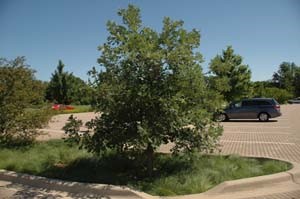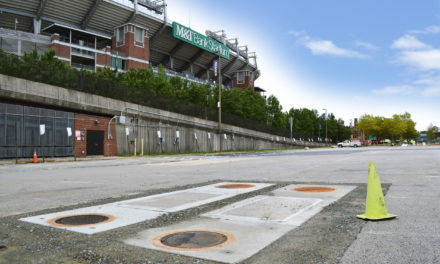
Trees at the Morton Arboretum studied for their stormwater benefits. Image provided by the Soil Science Society of America
In a study published in the Journal of Environmental Quality, researchers discovered that certain tree species were best at removing stormwater from bioswales and cycling runoff back to the atmosphere. The trees studied were planted in an upgraded parking lot at the Morton Arboretum, just outside of Chicago, in the 1990s. Partially funded by a grant from the Illinois Environmental Protection Agency, researchers designed a permeable-paver parking lot that included bioswales to clean and capture runoff and reduce the environmental effects of the parking lot and building.
Research showed that trees in bioswales of the Morton Arboretum parking lot accounted for 46% to 72% of total water outputs via transpiration.
“Trees may be best suited to improving the biofilter performance because of their large water demand associated with their large above- and below-ground biomass,” said Bryant Scharenbroch, corresponding author of the study and head of the Morton Arboretum Soil Science Laboratory.
However, not all trees perform equally well. The researchers found that those species with high stomatal conductance and large mature form are likely to contribute best to bioswale function.
The size of the trees’ leaves, their stomata, and their ability to withstand wide variations in water levels increased their water-removal performance. The bioswales seemed to benefit the trees as well, with some tree species growing larger within the bioswale compared to non-bioswale growing environments.
In addition to moving water into the canopy, tree roots keep the soil loose and healthy. Channels created by roots also help water move down through the soil and into the groundwater system. Additionally, tree roots support an active biological system of organisms functioning to store and clean water.
“Trees are very active in the water cycling of this parking lot,” Scharenbroch said. “The research clearly shows that trees are an integral part of the green infrastructure system and function to reduce runoff and discharge from the parking lot.”




